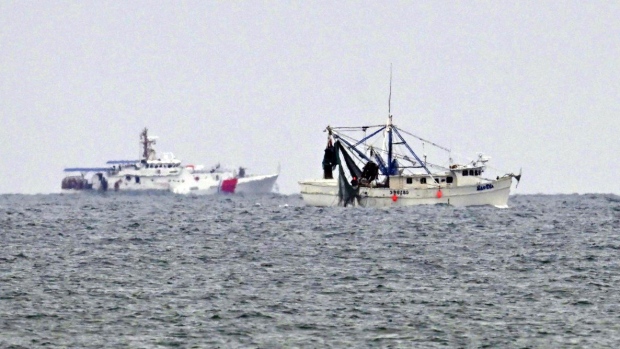Feb 6, 2023
Balloon Recovery Begins as US Weighs What China’s Leaders Knew
, Bloomberg News

(Bloomberg) -- The US has started to recover some parts from the Chinese balloon that an American F-22 fighter jet shot down off the coast of South Carolina, as Biden administration officials said the US was still trying to figure out how much senior leaders in Beijing knew about the alleged spy mission.
Debris from the balloon and its payload scattered over a patch of Atlantic Ocean measuring about 1,500 meters (4,900 feet) by 1,500 meters, and the US is surveying the site as it works to retrieve the wreckage, said General Glen VanHerck, head of the North American Aerospace Defense Command. He told a briefing Monday that one concern for the recovery teams was whether the equipment carried explosives or other hazardous materials.
Asked whether the balloon uproar had weakened US-China relations, President Joe Biden told reporters Monday, “No. We’ve made it clear to China what we’re going to do. They understand our position. We’re not going to back off. We did the right thing. And there’s not a question of weakening or strengthening. It’s just reality.”
On the question of why China would commit the brazen spying that the US claims, Biden said only that “they’re the Chinese government.”
Senators on Thursday will receive a classified briefing on the episode from administration officials, a spokesperson for Senate Majority Leader Chuck Schumer said Monday night.
Balloon’s ‘Maneuverability’
VanHerck said the balloon was a “maneuverable platform,” and the administration gained a better sense of what it could do during the time it moved across the US.
He said China used the balloon’s “maneuverability to strategically position themselves to utilize the winds to traverse portions of countries that they want to see. But this gave us the opportunity to assess what they were actually doing, what kind of capabilities existed on the balloon, what kind of transmission capabilities existed.”
The latest information only deepened the administration’s conviction that the balloon wasn’t “mainly” a weather-monitoring device as Chinese officials have claimed. In a briefing Monday, Chinese Foreign Ministry spokeswoman Mao Ning repeated China’s assertion that the balloon that passed over US territory last week was an “isolated incident.”
In a sign of more tension to come, the Chinese Foreign Ministry sharpened its tone Sunday after the American F-22 popped the balloon with a Sidewinder missile and sent its payload crashing into the Atlantic Ocean. Beijing called the decision a “clear overreaction” and said it reserved the right to respond.
“China will resolutely safeguard the legitimate rights and interests of the company concerned, and reserves the right to make further responses if necessary,” Chinese Vice Foreign Minister Xie Feng said, according to a Foreign Ministry statement released Monday. Xie lodged a formal diplomatic protest with the US Embassy in Beijing, the ministry said.
Now that the balloon is down and recovery efforts are underway, the administration also focused on determining whether top Chinese leaders were aware of plans to deploy the satellite over the US and whether it represented a more aggressive intelligence push. National Security Adviser Jake Sullivan said the administration was still trying to understand Chinese officials’ thinking on the matter.
“Sitting here today, I’m not going to characterize Chinese government’s either knowledge, intention, strategy, lack of strategy,” Sullivan told a forum in Washington. “Conclusions about kind of who knew what when, in Beijing, that’s something we’re still piecing through.”
It’s unlikely that Beijing intended to engage in a brazen provocation just days before Secretary of State Antony Blinken’s planned trip to Beijing, which has now been postponed, according to Gabriel Wildau, a China watcher and managing director at advisory firm Teneo Holdings LLC.
“Recent signals all suggested that Beijing hoped the visit would build on progress” from November’s meeting of Biden and China’s President Xi Jinping, he said. “The cancellation of the Blinken visit is clearly negative for markets in the short term, but if this storm quickly passes, markets could also revive.”
John Kirby, spokesman for the US National Security Council, told reporters that “it strains credulity, as we have been saying for many days, that this was some sort of innocent weather balloon that was just floating upon the winds.”
The US assessed that the balloon didn’t present an urgent intelligence-gathering threat and took “maximum protective measures” while it was transiting across the US to neutralize its intelligence-gathering capabilities and glean as much as was possible about its use by the Chinese, VanHerck said in his briefing.
“There was a potential opportunity for us to collect intel where we had gaps on prior balloons,” he said. “You’ll see in the future that that time frame was well worth its value to collect.”
Analysis of the 200-foot (61-meter) tall balloon’s payload, which he said was similar in size to a Embraer ERJ regional jet, allowed NASA to calculate the rough size of the potential debris field, and led to the US decision to shoot it down 6 miles (10 kilometers) off the coast of South Carolina, VanHerck said.
The recovery efforts, which include a Navy ship mapping the debris field, were well underway but had been complicated by the need for precautionary efforts to ensure the debris field was free of any explosives or hazardous materials from batteries, the general added. Those efforts began on Monday after choppy seas on Sunday had prevented those teams from operating, he added.
Key congressional aides involved in defense and intelligence issues will receive a briefing on the balloon saga from the Biden administration on Tuesday morning, according to a person familiar with the plans.
--With assistance from Jenny Leonard, Josh Wingrove, Jordan Fabian, Billy House, Jacob Gu and Steven T. Dennis.
(Updates with senators to receive briefing, in fifth paragraph.)
©2023 Bloomberg L.P.


